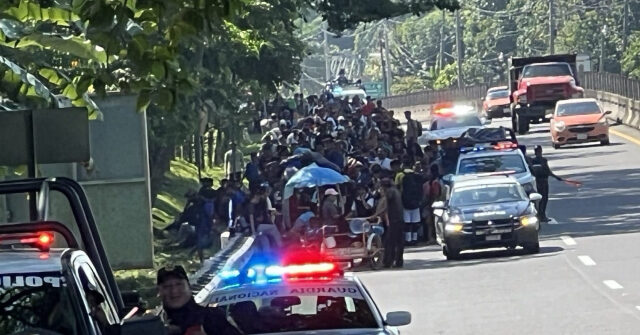A new migrant caravan recently set out from Mexico’s southern border, aiming to reach the U.S. before the possible imposition of a new administration under Donald Trump. Approximately 2,500 migrants began their journey from Tapachula, Chiapas, towards Mexico City, where the caravan is likely to disband before continuing northward. Historically, such caravans tend to split up upon reaching major cities, with migrants utilizing various forms of transportation like commercial flights and buses to continue their trek towards the United States.
The size of the caravan prompted the presence of Mexican police, who not only escorted the migrants but also directed traffic around them. In an interview, a high-ranking official from Mexico’s National Immigration Institute (INM) highlighted that many participants had spent months in Chiapas, awaiting their appointments with U.S. Customs and Border Protection (CBP) via the Biden-Harris administration’s CBP One app. Many of these migrants entered Mexico legally, having requested and obtained permits that allow them to remain in the country as they navigate the lengthy immigration process.
According to the INM official, despite the long waiting periods for scheduled hearings, uncertainties around changing asylum policies under a potential new administration prompted many to join the caravan. The urgency seemed to intensify as various recent caravans emerged, suggesting a collective concern among migrants that they may lose their opportunity to secure asylum in the U.S. should rules or regulations shift.
With most caravan participants holding valid permits, Mexican immigration enforcement faced limitations in terms of intervention, leading them to observe rather than disrupt the group’s movements. Law enforcement agents were reported to document the situation internally, including taking photographs of the caravan’s progress, possibly to monitor the trend of such organized migrations.
Amid the conflicting immigration narratives, Mexico’s President Claudia Sheinbaum publicly criticized Trump over his claims regarding potential tariffs on Mexico if the country failed to mitigate the surge of migrants traveling towards the U.S. The tensions reflect broader diplomatic challenges as both nations grapple with intricate immigration policies, political rhetoric, and the humanitarian situation arising from the mass migrations.
The caravan’s departure is a significant indicator of ongoing migration issues in the region, with thousands of individuals hoping to escape difficult living conditions in their home countries. The involvement and reactions of Mexican authorities and political figures underscore the complexity of managing such large movements of people and navigating the political implications tied to U.S.-Mexico relations. The broader implications for U.S. immigration policy, regional cooperation, and humanitarian considerations remain to be seen as the situation unfolds.

